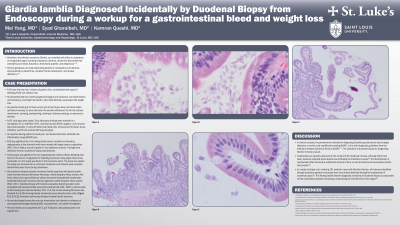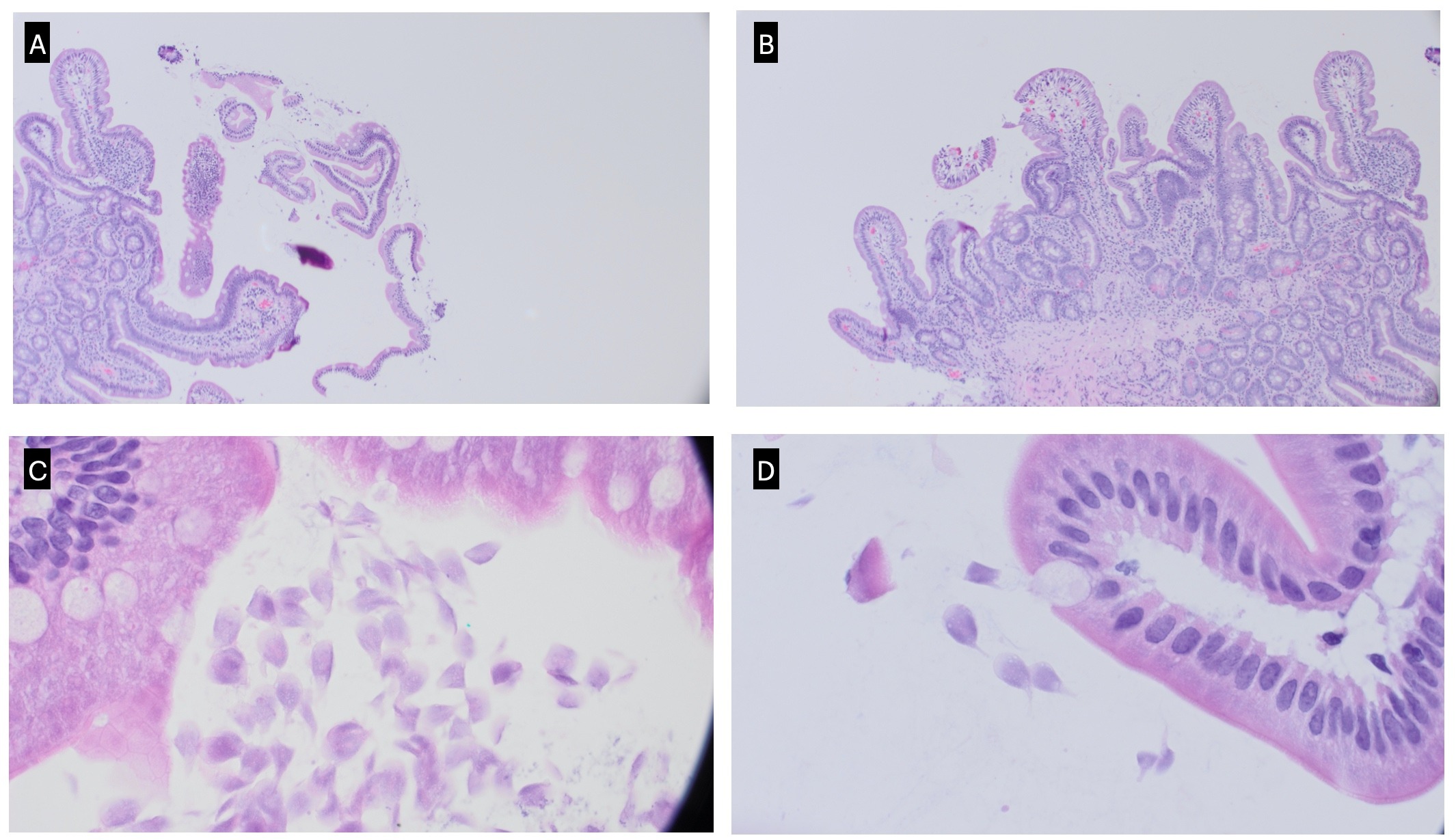Monday Poster Session
Category: Small Intestine
P3303 - Giardia lamblia Diagnosed Incidentally by Duodenal Biopsy from Endoscopy During a Workup for a Gastrointestinal Bleed and Weight Loss
Monday, October 28, 2024
10:30 AM - 4:00 PM ET
Location: Exhibit Hall E

- MY
Mei Yang, MD
St. Luke's Hospital
Chesterfield, MO
Presenting Author(s)
Mei Yang, MD1, Eyad Z. Gharaibeh, MD2, Kamran Qureshi, MD2
1St. Luke's Hospital, Chesterfield, MO; 2SSM Health Saint Louis University Hospital, St. Louis, MO
Introduction: Giardia duodenalis is an effective intestinal parasite responsible for inducing waterborne diarrhea, fatigue, stomach cramps, nausea, weight loss in humans.
Case Description/Methods: A 56-year-old man has a medical history of gastric ulcer complicated with upper GI bleeding, alcohol use, and tobacco use. He presented with two months of progressive fatigue and weakness, one week of melena and hematuria, and bright red blood in stool intermittently, associated with weight loss. He reported drinking 6-10 beers and a pint of hard liquor daily. He did not endorse recent travel, camping, backpacking, working in childcare settings, or animal exposure.
In the ED, vital signs were stable. Labs showed hemoglobin of 4.2 with MCV of 65 and alcohol level negative. 4 units of Packed red blood cells, Intravenous (IV) proton pump inhibitors, and IV iron sucrose 200mg were given. He reported taking aspirin for back pain and denied other non-steroidal anti-inflammatory drugs (NSAID) use. Liver function tests were normal. He was taken for Esophagogastroduodenoscopy (EGD) which showed multiple non-bleeding angioectasias in the stomach, which were treated with argon plasma coagulation (APC). These are likely a source of the patient's iron deficiency anemia. A Duodenum biopsy was obtained. Colonoscopy showed two angiodysplastic lesions found in the cecum without bleeding. Coagulation for bleeding prevention using argon plasma was successful. A 4 mm sessile polyp was found in the transverse colon which was removed.
Next day, patient was stable and discharged to home. He was suggested to follow up with his PCP in 1 week for CBC and started on daily pantoprazole, an iron supplement. His duodenum biopsies showed numerous Giardia organisms with typical double nuclei and teardrop and fall leaves-like shapes visible along the villous surface, with intact villous and crypt architecture without increased intraepithelial lymphocytes [Figure A,B,C,D]. Transverse colon polyp biopsies showed tubular adenoma. He was treated as an outpatient with 2 g of Tinidazole.
Discussion: Duodenal giardiasis constitutes a prevalent intestinal infection that has diverse manifestations. But weakness, melena, and weight loss in our case are very rare. When stool studies and duodenal aspirate microscopy with negative results, suspicion for Giardia persists is very important, that clinicians should contemplate the option of conducting a duodenal biopsy.

Disclosures:
Mei Yang, MD1, Eyad Z. Gharaibeh, MD2, Kamran Qureshi, MD2. P3303 - Giardia lamblia Diagnosed Incidentally by Duodenal Biopsy from Endoscopy During a Workup for a Gastrointestinal Bleed and Weight Loss, ACG 2024 Annual Scientific Meeting Abstracts. Philadelphia, PA: American College of Gastroenterology.
1St. Luke's Hospital, Chesterfield, MO; 2SSM Health Saint Louis University Hospital, St. Louis, MO
Introduction: Giardia duodenalis is an effective intestinal parasite responsible for inducing waterborne diarrhea, fatigue, stomach cramps, nausea, weight loss in humans.
Case Description/Methods: A 56-year-old man has a medical history of gastric ulcer complicated with upper GI bleeding, alcohol use, and tobacco use. He presented with two months of progressive fatigue and weakness, one week of melena and hematuria, and bright red blood in stool intermittently, associated with weight loss. He reported drinking 6-10 beers and a pint of hard liquor daily. He did not endorse recent travel, camping, backpacking, working in childcare settings, or animal exposure.
In the ED, vital signs were stable. Labs showed hemoglobin of 4.2 with MCV of 65 and alcohol level negative. 4 units of Packed red blood cells, Intravenous (IV) proton pump inhibitors, and IV iron sucrose 200mg were given. He reported taking aspirin for back pain and denied other non-steroidal anti-inflammatory drugs (NSAID) use. Liver function tests were normal. He was taken for Esophagogastroduodenoscopy (EGD) which showed multiple non-bleeding angioectasias in the stomach, which were treated with argon plasma coagulation (APC). These are likely a source of the patient's iron deficiency anemia. A Duodenum biopsy was obtained. Colonoscopy showed two angiodysplastic lesions found in the cecum without bleeding. Coagulation for bleeding prevention using argon plasma was successful. A 4 mm sessile polyp was found in the transverse colon which was removed.
Next day, patient was stable and discharged to home. He was suggested to follow up with his PCP in 1 week for CBC and started on daily pantoprazole, an iron supplement. His duodenum biopsies showed numerous Giardia organisms with typical double nuclei and teardrop and fall leaves-like shapes visible along the villous surface, with intact villous and crypt architecture without increased intraepithelial lymphocytes [Figure A,B,C,D]. Transverse colon polyp biopsies showed tubular adenoma. He was treated as an outpatient with 2 g of Tinidazole.
Discussion: Duodenal giardiasis constitutes a prevalent intestinal infection that has diverse manifestations. But weakness, melena, and weight loss in our case are very rare. When stool studies and duodenal aspirate microscopy with negative results, suspicion for Giardia persists is very important, that clinicians should contemplate the option of conducting a duodenal biopsy.

Figure: Figure A: Duodenal biopsy with numerous Giardia organisms visible along the villous surface (H&E, 100×).
Figure B: Duodenal biopsy with numerous parasites featuring double nuclei compatible with Giardia lamblia around the intestinal villi (H&E, 1000×).
Figure C: Giemsa stain at 40x showing tear-drop-like Giardia.
Figure D: H&E at 40x showing Giardia duodenalis surrounding the entire villus.
Figure B: Duodenal biopsy with numerous parasites featuring double nuclei compatible with Giardia lamblia around the intestinal villi (H&E, 1000×).
Figure C: Giemsa stain at 40x showing tear-drop-like Giardia.
Figure D: H&E at 40x showing Giardia duodenalis surrounding the entire villus.
Disclosures:
Mei Yang indicated no relevant financial relationships.
Eyad Gharaibeh indicated no relevant financial relationships.
Kamran Qureshi indicated no relevant financial relationships.
Mei Yang, MD1, Eyad Z. Gharaibeh, MD2, Kamran Qureshi, MD2. P3303 - Giardia lamblia Diagnosed Incidentally by Duodenal Biopsy from Endoscopy During a Workup for a Gastrointestinal Bleed and Weight Loss, ACG 2024 Annual Scientific Meeting Abstracts. Philadelphia, PA: American College of Gastroenterology.
